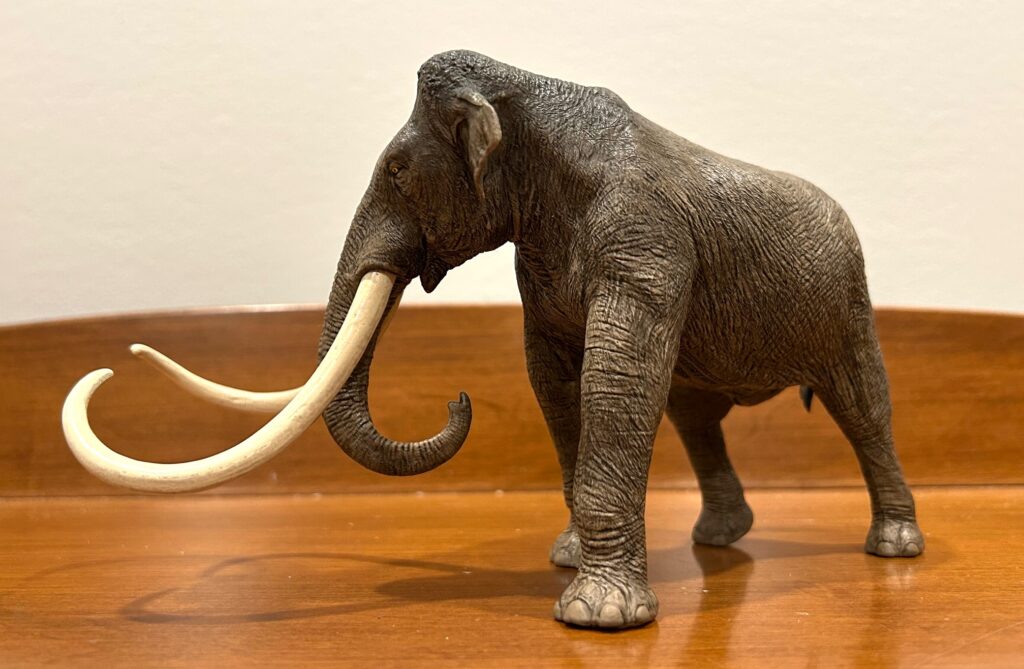
About 1.5 million years ago, a population of steppe mammoths (Mammuthus trogontherii) entered North America from Siberia via the Bering Strait. As they migrated south into the warmer regions of the United States and Mexico, they soon gave rise to a new mammoth species, M. columbi, better known as the Columbian mammoth. It was the largest land mammal known to have inhabited the New World, standing more than 4 metres tall and weighing 10 to 13 tons. Its teeth were first discovered in 1725 in South Carolina by Black slaves, who unanimously recognised them as being elephant teeth. This means that it has the honour of technically being the very first prehistoric animal from North America to be identified (mammoths are elephants, after all). It was formally described and named in 1857 after the explorer Christopher Columbus, which has always struck me as rather silly given that Columbus never set foot anywhere on the North American continent in his life. I much prefer the imperial mammoth moniker instead (that’s what I grew up calling it), but that’s presently considered a junior synonym. Anyway, a great many specimens of this pharaonic pachyderm have been found from one end of the continent to the other over the centuries, including bulls, cows, and calves. Its skeleton is completely known and many museums feature one in their Cenozoic exhibits.


Despite its relative fame and being known from complete skeletal remains, the Columbian mammoth has not had any toys to its name up until now (in stark contrast to its close cousin M. primigenius, the woolly mammoth). Leave it to Eofauna to give us the very first, one of three new prehistoric toys from them for 2025. And it’s a good-sized one, standing a little under 12 cm tall at the head and measuring 20 cm long from the curve of its left front tusk to the heel of its extended left hind leg. Like all Eofauna toys, it comes with an information card. Tough luck for that glyptodont.



Whereas Eofauna’s previous prehistoric pachyderms have been sculpted in rather aggressive stances, this mammoth looks more laid back. It is in a walking pose with the limbs on its left side extended forward and back and its head turned to the right with the trunk dangling down and the tip curling back. This feckful individual might simply be lumbering along in search of food. Like all the other Eofauna proboscideans, it is clearly a mature bull. It weighs in at 376 g, making it the third heaviest after the 404 g Deinotherium and the 486 g straight-tusked elephant.

The mammoth is coloured a dull muddy brown with black wash. The soles of its feet are a lighter shade of brown, the very top of its head and neck are a darker shade, the tail tuft is black, the eyes are light orange, and the tusks are beige. The paint work is excellent, with nary a flaw to be seen, and it is precisely the sort of colouration one sees on Asian elephants today.

Unlike the woolly mammoth, the Columbian mammoth inhabited a much warmer climate and therefore would have had no need for an insulating coat of fur. As such, it is generally depicted with little or no hair on its body, and in this particular case, there is no visible hair save for the tail tuft and a smattering atop the cranium. The skin texture is typically elephantine: very wrinkled and baggy, and it is sculpted to look as realistic as possible. The pear-shaped torso is sloped, with the shoulders positioned much higher than the rump, and the head positioned even higher. The legs are long and muscular, especially the front pair. The tail is shorter than a modern elephant’s, but also much longer than a woolly mammoth’s.

The tusks on this mammoth extend downward from the skull, then curve upward and finally inward, leaving just a small gap between the blunt tips. Looking at them from the front, one can clearly see that the tusks are asymmetrical, which adds to the realistic appearance. Faint grooves are discernible on them too. And fear not, they are made of softer plastic to prevent breakage. Out of all the currently existing Eofauna proboscideans, these tusks are the longest (although the straight-tusked elephant’s are more massive), and they look very intimidating and formidable. They would have been used for display purposes, for defense against would-be predators, and for intraspecific conflict. Indeed, two male specimens from Nebraska were discovered with their tusks interlocked, clearly the unintended result of a titanic clash. Poor chaps.

The long, wrinkled trunk features a single manipulating “finger” at the tip, again just like on Asian elephants. The mouth is closed, so no commenting on dentition. The head is tall, with a large, bulging cranium and rather small ears, again bigger than a woolly mammoth’s, but smaller than modern elephants’. The tiny eyes are wide and alert, although as I noted earlier, the stance suggests that this individual is not in an excited state. The Columbian mammoth lived alongside some of the most famous Pleistocene megafauna, including giant sloths, giant camels, giant bison, mastodons, and in some areas, woolly mammoths, and there is evidence that Columbian and woolly mammoths interbred now and then. Contemporary carnivores included the dire wolf, the machairodonts Homotherium and Smilodon, the American lion, the short-faced bear Arctodus, and also surviving ones like the grey wolf and the brown bear. But it’s difficult to envision any of that lot attempting to attack a healthy mature bull like this one.


From the get-go, Eofauna has been the top company in terms of proboscideans and the Columbian mammoth carries on that proud reputation (as does the new American mastodon). It is beautifully sculpted, well-researched, and unique (for now, at least), and it has a distinct air of charisma and majesty to it. One can only wonder which prehistoric beasts Eofauna will tackle in the future (Platybelodon and Stegotetrabelodon immediately spring to mind), but as long as they retain the exact same quality as this mighty mammoth, no one shall be the least bit disappointed!

And of course, it would be just wrong to end this review without showing all six of the current Eofauna proboscideans parading proudly together. Nobody else does them better!



This review is dedicated to my father, who passed away in March at the age of 94 after a lengthy decline. He himself was never into dinosaurs and other prehistoric animals, but he definitely encouraged my childhood fascination with them by taking me to museums and buying me lots of books such as the one shown below, which I received back in 1987. Also a new toy now and then, of course.

And I most definitely inherited his bold, precise, intellectual nature. Thanks for everything, Dad. You did me good. 🙂

Trending Products










